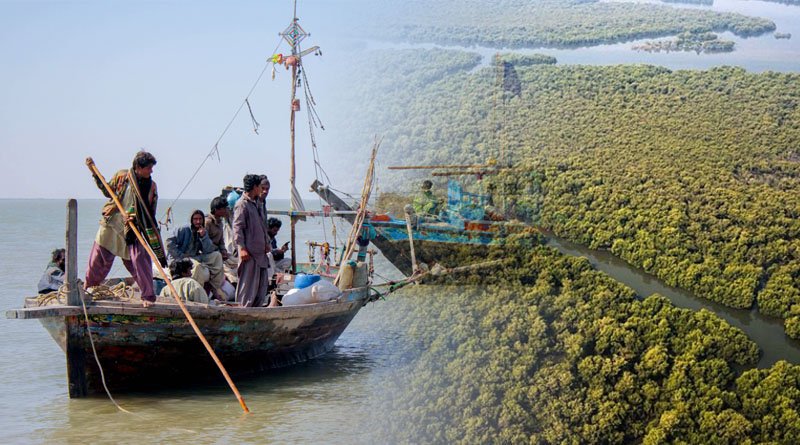“The delta’s condition is deteriorating day by day. The main reason is a lack of freshwater inflow in the Indus River”, said Dr. Altaf Ali Siyal.

Delta is a place where the Indus River falls into the Arabian Sea in Kacho Chhan, near Thatta. The Indus is the world’s fifth largest delta, but it has been drying up due to a lack of adequate freshwater inflow since the Raj built the first barrage in the 1920s.
“The delta’s condition is deteriorating day by day.” The main reason is a lack of freshwater inflow in the Indus River. Dr. Altaf Ali Siyal, Dean of the Faculty of Agricultural Engineering at Sindh Agriculture University, Tandojam, says
“But luckily this year we have got plenty of water due to rains in Balochistan and Sindh.” More than 42 million acre feet (MAF) of water have passed through the Kotri barrage and into the Indus delta since July. “It will undoubtedly benefit the environment, ecology, aquatic life, and the delta.”
IT’S a misty winter morning in the Indus Delta. Haji Muhammad Moosa Jatt, like a young man, leaps into his boat. Moosa, now in his 60s, has been a fisherman for decades, but this year’s fishing season has given his ageing body a new soul.
“After 12 years, the delta has received plenty of freshwater from the mighty Indus River. “This means there are plenty of fish,” he explained, happily standing on the deck of his 20-foot-long fishing boat. And this, he claims, has come after a decades-long wait.
“The fishermen are overjoyed. “Their families are happy, too,” the bulky man quickly adds. He gives instructions to his crew before departing from Keti Bunder, one of the oldest jetties in Asia.
Nearby, young fishermen are bringing new nets, carpenters are repairing old boats, and mechanics are fixing faulty engines. It’s a sign of busy days ahead this year.
Mr. Jatt’s use of a white Arabic-style scarf to cover his head indicates that he was once wealthy enough to perform Haj. However, this prosperity vanished decades ago.
The village of Moosa Jatt is named after him, attesting to the respect the veteran fisherman has earned over the years. His fishing expeditions did not stop at the delta or the Arabian Sea but extended all the way to the Gulf.
However, in recent decades, his activities have been limited to the Arabian Sea—and even then, to salty waters—as the delta has slowly but steadily died.
According to available data, the Indus delta covered 13,000 square kilometres and had 17 creeks in 1828–29. However, it now only has two active creeks: Khobar and Khar. And the active area has shrunk by 90% to just 1,050 square kilometres. “This is concerning.”
“Certainly, the environment, ecology, and coastal life have been impacted by the lack of freshwater inflow,” he claims.
Muhammad Hashim is a farmer who is 50 years old. He drives me 10 kilometres on his motorcycle to show me what had happened to his ancestors’ once fertile lands.
“When I was a kid, the sea was far away from agricultural lands,” he recalls, standing on an embankment built to keep the sea out. He waves to the horizon, where the sky and the sea appear to merge.
“Around 400 acres of farmland handed down from generation to generation is now submerged,” he says, his face filled with helplessness. “The sea level has risen above our heads in the last 20 to 25 years,” Hashim says, his face contorted with pain.
Dr. Siyal, an environmentalist, believes that rising sea levels and their intrusion into the delta are the second major problem threatening agriculture.
“The sea level has risen by one metre in the last century” (in Pakistan). “While Pakistan contributes only 0.1 percent of industrial pollution, it is one of the top ten countries suffering from the effects of greenhouse gases and climate change.”
He estimates that 8.6 million acre feet of freshwater must inflow through the delta each year, or approximately 5,000 cusecs per day.
Mr. Siyal recalls that the Indus was supposed to receive 10 million acre feet (MAF) of water per year under the 1991 Indus Water Apportionment Accord. It was also agreed that another 25 MAF would be added to the river, but this agreement was not followed through on.
According to the expert, the country survives primarily on two rivers, but since 15 hydraulic structures in the shape of barrages and dams have been built on them, the Indus delta has not gotten its due share since the 1950s.
“On average, 100 MAF should pass through the Kotri barrage in order to enter the Indus delta and survive.”
Hashim attempts to drink a handful of water to see if fresh water has contaminated the salty seawater. But he spit it out right away. “It’s sea water.” “It has a salty flavour.” “There used to be about 100 human settlements on these lands.” “The Jatts, Samo, and Qaburani communities fled to safer areas to save their lives,” he reminisces.
We drove through desolate terrain where the Army set a Guinness World Record by planting over 847,000 mangrove saplings in one day in 2013. The goal was to reforest the delta and provide a natural habitat for fish to reproduce.
Hashim, whose forefathers were fishermen, switched to farming to make a living years ago. Riding over dried-up earth with no signs of the world record mangrove plantation, he expresses an apprehension that the entire area would go under water in five to six years, making it “impossible for us to live here anymore.”
“I’ll be left with nothing and will have to abandon the land of my forefathers. I’ll have to choose between working as a labourer and going hungry.”